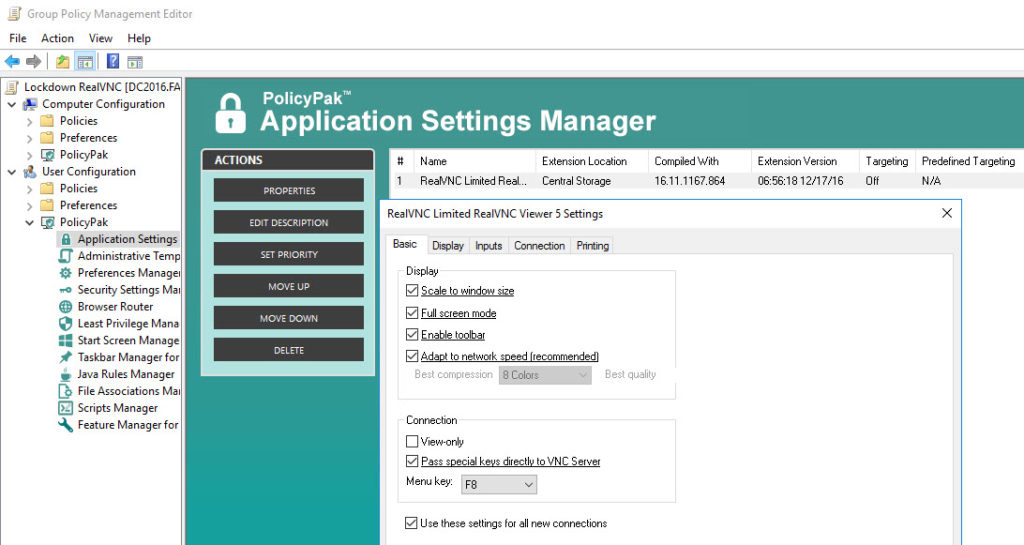VNC – it’s one of the original Remote Desktop Applications.
You want your users to remote into other machines effortlessly, without having to initiate another help desk call to do it.
If Real VNC Viewer is deployed to even some of your users’ or administrator’s machines, you’ve got no way to manage this application. Users can simply work around your settings. And that’s when bad things can happen for such a critical application that keeps your employees connected to the resources they must have every day to do their job.
With PolicyPak, you’re the one in control.
Thanks to PolicyPak, you’ll know that the VNC configuration settings that you assign to your users will always be preserved and operational, making sure your users can easily connect to their remote desktops.
Make sure that the settings for Real VNC viewer aren’t “worked around” by your users. Check out this video to see how it’s done..
Besides, once you’re using PolicyPak to manage Real VNC, you’ll also get to manage all your other enterprise desktop applications the same way: Flash, WinZip, Firefox, and any custom applications you have. They’re 100% included – absolutely free.
It’s all included when you’re a PolicyPak Professional customer.
PolicyPak was designed by Microsoft MVP, Enterprise Mobility Jeremy Moskowitz – who “wrote the book” on Group Policy, runs GPanswers.com, and lives and breathes Group Policy and enterprise software deployments and desktop lockdown.
When you’re ready to get serious about managing Real VNC, PolicyPak is ready for you.
Manage Microsoft VNC Viewer with Group Policy video transcript
Hi, this is Jeremy Moskowitz, Microsoft MVP, Enterprise Mobility and Founder of PolicyPak Software. In this video, we’re going to learn how to use PolicyPak to manage Real VNC Viewer.
I’ve already got VNC Viewer installed on my computer, and I’m just a regular user here. As you can see, I’m logged on as a guy called “eastsalesuser4.” If we open up the application here from the Start Menu and click “Options” we see that we have various settings here to choose from. Now if I click the Advanced button here, I open up more tabs with additional configuration options. I have some key settings here on the “Inputs” tab and if I go to “Connection” I have some important settings if I need to enforce a proxy server. Let’s go over and see how we would manage these settings quickly using PolicyPak. I’ll go ahead and switch over to my Management Station computer.
We’ll go ahead and right click over our “East Sales Users”, “Create a GPO” and we’re going to call it “Lockdown VNC Viewer.” So this GPO is now associated with the “East Sales Users.” I’ll right click over it. I’ll click “Edit…”. I’ll dive down under “User Configuration,” “PolicyPak/Applications/New/Application.” There it is, “PolicyPak for VNC Viewer” along with our other applications like “WinZip,” “Media Player,” “Firefox,” “Skype” and some other things.
Let’s go to “Basic” and let’s change the “Menu Key” to F10. Then let’s head over to “Inputs” and let’s turn on all of these setting options. Notice how when I checked or unchecked each setting that the text became underlined. That means that the setting value is going to be delivered to the user. The same would apply if I wanted to deliver an unchecked value as well. I’m going to change the “Menu Key” here as well to F10.
Now let’s demonstrate the full capability of PolicyPak and go to “Connections.” Let’s select “Use these proxy settings.” I will type in an IP address here, 172.16.55.1. Then I’m going to right click over the setting and select “Hide corresponding control in target application.” This is going to completely hide this text box from my users making them completely unaware there is even a setting option here. Next I’m going to select “HTTP Connect” and then I will right click on it and select “Disable corresponding control in target application.” Let’s find out what happens.
I’ll go back to my client machine, we’ll get a command prompt and run “gpupdate.” Now again, we could envision the user just logging on for the very first time or changing job roles or getting a new computer. As soon as they do, they’re going to get these settings. I just happen to be using gpupdate to do that.
Now that that’s done, let’s reopen the application again. As you can see, when I go to “Basic” I see that the “Menu Key” has been changed accordingly. In addition, if I go to “Inputs,” all of my desired setting values have been delivered as well as the newly assigned “Menu Key” again. And now for the closer. If I go to Connections, we see that the proxy address setting text box is no longer present on the tab and my other setting text box has been disabled. Not only are those setting values being enforced but there is no way that my users can alter these settings.
And we are done. That is how incredibly easy it is for you to use PolicyPak to manage and lockdown VNC Viewer and tons of other desktop applications.
If you’re looking for a trial of PolicyPak, just click on the “Webinar / Download” button on the right.
Thanks so much for watching, and get in touch with us if you’re looking to get started. Talk to you soon.




